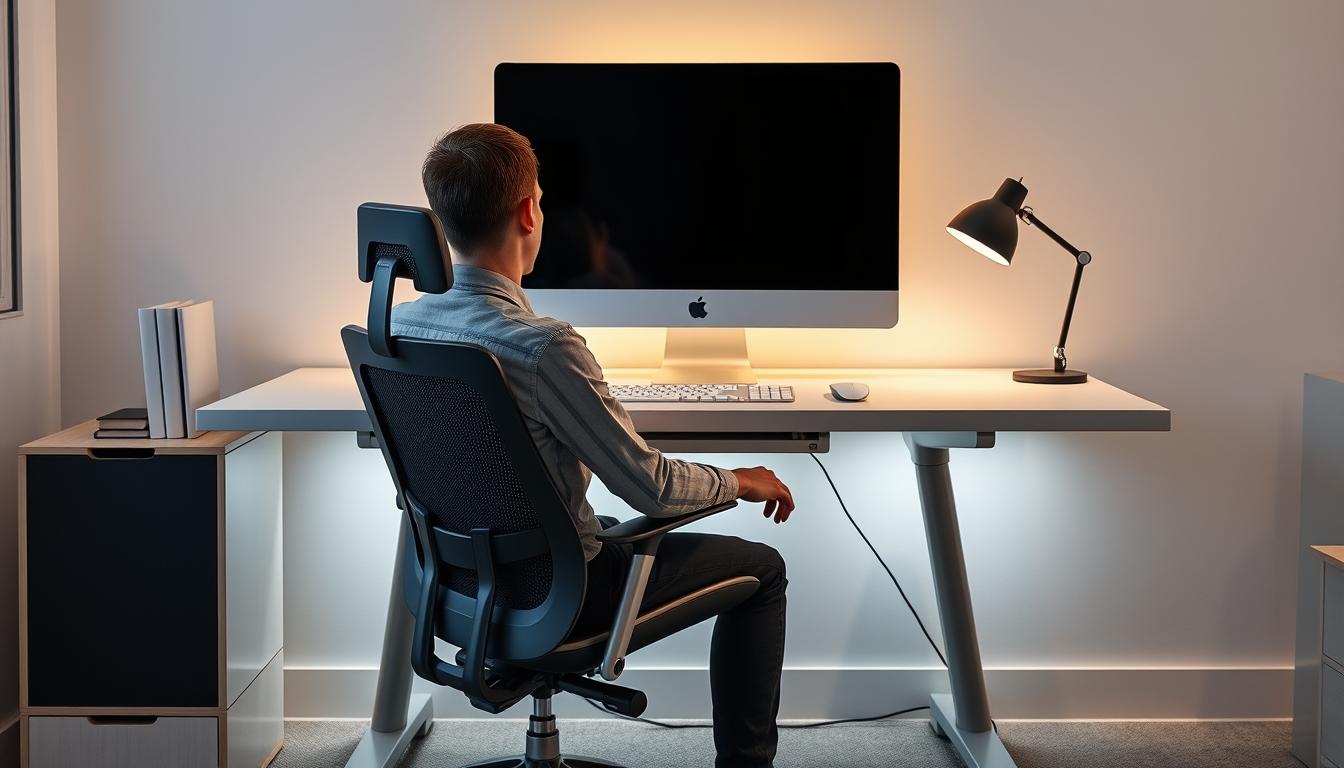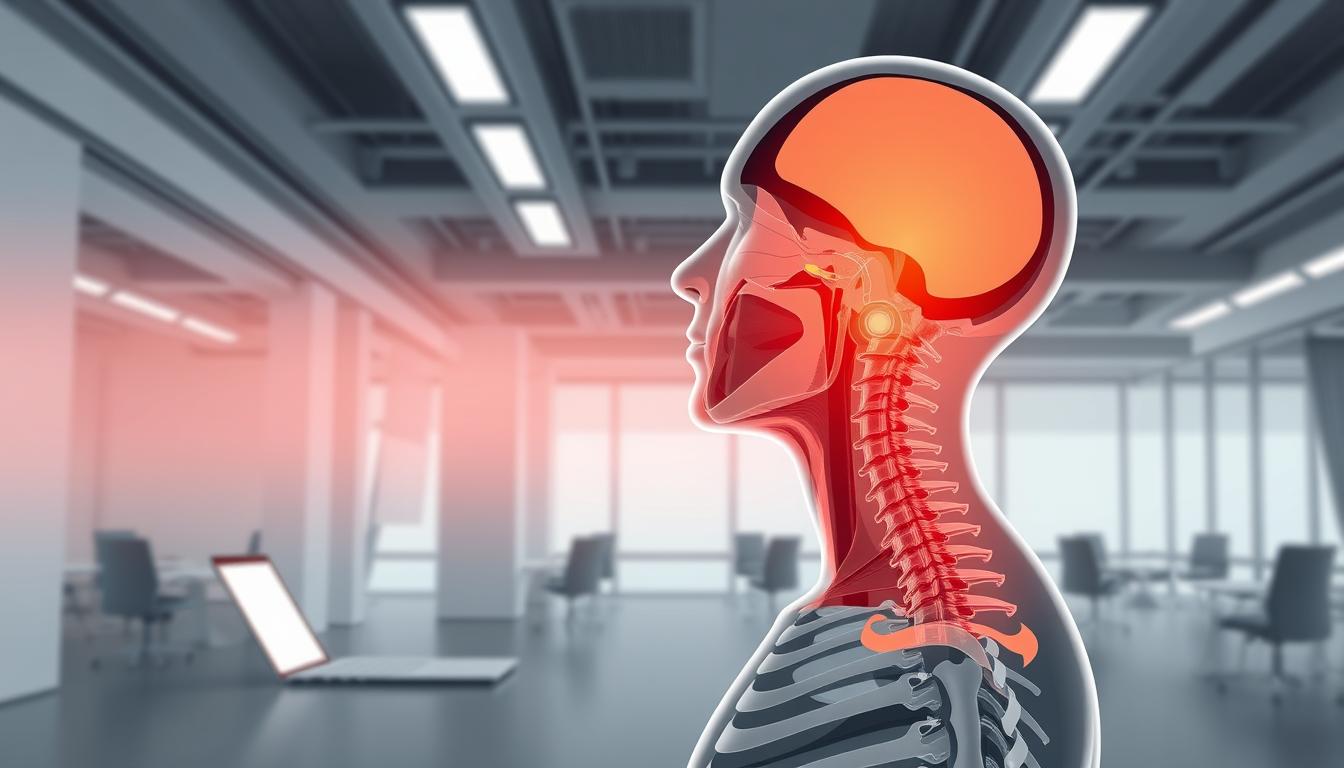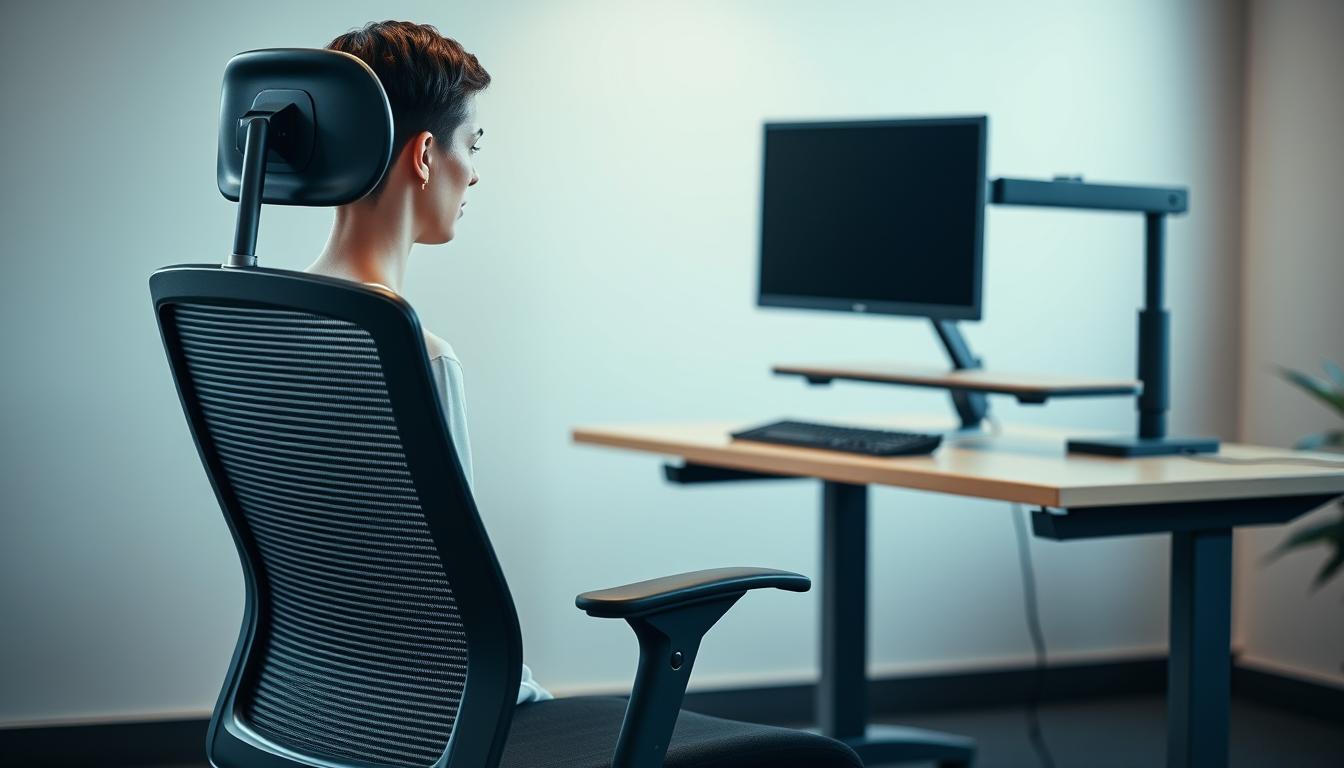Nowadays, college students use laptops a lot for their studies. Having the right setup is important to make study time more effective. A good ergonomic space boosts productivity and lessens body pain. This helps students concentrate more on their work. We’ll share tips on making a comfy study area just for college students. This way, they can use their time and energy to study better.
Understanding Ergonomics and Its Importance
Ergonomics is key for a good study spot that helps college students do well and feel good. It’s about making work areas that meet each student’s needs. By using the right ergonomic tips, students can do better in school and be more comfortable.
Definition of Ergonomics
The study of ergonomics aims to make people and their workplaces work better together. It’s not just about comfort but also working smarter and staying safe. Knowing about ergonomics helps students avoid injuries and other issues from bad desk setups.
Benefits of Proper Ergonomic Practices
Good ergonomic habits bring many health pluses. Some key benefits are:
- Less strain and discomfort when studying
- Better focus and more work done
- Feeling better overall, which helps with school success
When students think about ergonomics, they can juggle school and fun times better, making studying healthier and more fun.
Impact of Sedentarism on College Students
Sedentarism hits college students hard, mainly because they sit a lot for studying. Many don’t know how risky long sitting periods can be. These risks can bring serious health issues over time. It’s key for students to know about these effects to stay healthy while studying.
The Risk Factors Associated with Extended Sitting
Long hours of sitting bring many health risks, such as:
- Increased back and neck pain
- Higher chances of developing obesity
- Increased risk of cardiovascular diseases
- Lower energy levels and productivity
Studies compare the risks of sitting too much to those of smoking. Bad habits formed in college can affect one’s health for years.
Statistics on Sedentarism in Academic Settings
A study in the British Journal of Sports Medicine shows worrying numbers:
- Students sit for about 8 hours daily for study or classes.
- They should stand 2-4 hours a day to reduce sedentarism risks.
This data underlines the importance of watching out for health risks from sitting too much. By taking action, students can lessen the health issues from not moving enough.
Creating an Ergonomic Study Space
Creating a good study area is key for college students to do well. An ergonomic space makes studying more comfortable and helps you focus better. Start by picking the right spot and setting up your workspace well.
Choosing the Right Location
Look for a quiet place with few distractions to help you concentrate. Choose an area with natural light to boost your mood and keep you alert. Having a special spot for studying helps you focus without interruptions, which is great for learning hard topics.
Organizing Your Study Area for Productivity
Keeping your workspace organized is important for working efficiently. Make sure everything you need is close by so you don’t lose focus. Use items that let you sit or stand in different ways to keep moving and avoid getting tired. A neat workspace helps you study better and feel in control of your tasks.
Laptop Ergonomics for College Students
Studying well needs more than just books and managing time. It’s crucial to use your laptop the right way. If you sit poorly or set up your laptop incorrectly, you can start to feel uncomfortable. This can make you lose focus. Making sure you sit right, place your screen well, and keep a good posture are key steps for a great study setup.
Here are some smart ways to make your laptop friendlier to your body:
- Put the laptop screen at the same height as your eyes to avoid hurting your neck.
- Choose a comfy chair that keeps your back straight, especially if you study for hours.
- Make sure the keyboard is at a level where your elbows can relax without strain.
- Your feet should be flat on the ground to help keep your body lined up right.
Following these tips can help you stay focused and comfortable while you study. Putting your laptop’s ergonomics first can make learning more fun and effective.
Selecting the Right Laptop Accessories
Choosing the right ergonomic laptop accessories can really improve your comfort and work quality during long study times. Two key accessories are important for your setup: external keyboards and ergonomic mice. They help lower strain and encourage better posture while you’re on your laptop.
External Keyboards for Comfort
External keyboards are a great choice over your laptop’s built-in one because they offer better wrist positioning. A well-made external keyboard helps keep your wrists in a neutral position. This significantly cuts down on the risk of injuries from repeating the same motions. Companies like Logitech and Keychron have products that suit different typing needs, making them great for ergonomics. Making the switch to an external keyboard can make studying much more comfortable.
Ergonomic Mice and Their Benefits
Ergonomic mice change the way you work by supporting healthier hand positions. Trackpads can make you hold your wrist in uncomfortable ways. But ergonomic mice, like those from Razer or Microsoft, are shaped to fit your hand naturally. This design keeps you comfortable for longer and helps avoid problems like carpal tunnel syndrome. Getting ergonomic laptop accessories, including these mice, helps students stay healthy while they focus on their studies.
Setting Up Your Laptop Workspace
Creating a good laptop workspace is key to being productive and comfy. Paying attention to how high your desk is and where your screen is can really change how you feel when studying. If you set things up right, you won’t get sore and can stay focused longer.
Optimal Desk Height and Position
Your desk’s height is super important. When you sit and type, your elbows should bend at 90 degrees. This helps keep your shoulders and wrists relaxed. Adjustable desks are great for this because you can change them to suit you just right. Make sure your chair height matches your desk to keep your sitting posture good.
Screen Height and Distance Recommendations
Where your screen is placed matters a lot too. Keep your monitor about 20 inches from your eyes. This makes reading easier and stops your eyes from getting tired. The top of the screen should be level with or a bit lower than your eyes. This helps keep your neck comfy and stops it from getting stiff after sitting for a while. You might need to tweak these settings to get them just right for you.
Choosing the Right Chair for Long Study Sessions
When you dive into long study hours, the chair you pick is key. A chair that’s designed right enhances comfort and helps you stay focused. By adjusting it to fit you, discomfort during long sits is decreased.
Key Features to Look for in an Ergonomic Chair
Getting an ergonomic chair comes with a lot of pluses. Make sure to check for these features:
- Adjustable seat height for proper leg positioning.
- Lumbar support that promotes the natural curve of the spine.
- Comfortable armrests that reduce strain on shoulders.
- A supportive backrest to alleviate pressure on the vertebrae.
Adjustability and Support for Good Posture
Being able to adjust your chair is key for maintaining a good posture. Changing the seat height, backrest angle, and armrest position lets you find the best support. A chair that fits you well is important for comfort and prevents body aches over time.
Lighting Considerations for Your Study Area
Good lighting is key for a great study space. It makes everything clearer and keeps your eyes from getting tired. It also helps you stay focused while studying for a long time. Make sure the light quality in your study area is good to keep distractions away.
Choosing the Right Type of Lighting
Sunlight is usually the best for studying. But if you can’t get natural light, you have to pick the right artificial lights. Some good options are:
- LED desk lamps: Provide focused light with minimal heat.
- Full-spectrum bulbs: Mimic natural daylight, offering brightness and color accuracy.
- Adjustable task lights: Allow customization of brightness and angle to avoid shadows.
Minimizing Glare on Your Screen
Glare can make it hard to work and cause discomfort. It’s important to know how to keep it away from your study spot. Here’s how:
- Position your screen away from windows to prevent reflections.
- Use anti-glare filters on monitors to lessen harsh reflections.
- Adjust the brightness of your screen to match ambient lighting levels.
The Importance of Taking Breaks
College can be tough, with its intense study demands. Taking breaks is key to keep focused and avoid feeling overwhelmed. Studies show that breaks can actually help you do better in school. They make it easier to remember what you learn.
How Breaks Enhance Productivity
Breaking up study time helps your brain rest. Experts say to take a 10-15 minute break after studying for an hour. This keeps you from getting too tired and makes learning tough topics easier.
Effective Break Strategies for Students
Here are some great ways to make the most of your breaks:
- Get moving with activities like stretching or walking to help your blood flow better.
- Try relaxing deep breathing or meditation to clear your mind and lower stress.
- Talking with friends for a bit can boost your mood and motivation to study more.
Taking breaks the right way can really help you focus better and be more productive in your studies.

Tips to Minimize Eye Strain
Today, screens are everywhere in our lives. It’s important to find ways to reduce eye strain. Setting up your monitor the right way and using good habits can make looking at screens easier. This is especially true for those long hours spent studying. We must make an effort to protect our eyes.
Monitor Positioning and Adjustments
It’s key to adjust your monitor screen to avoid eye strain. Place the screen about an arm’s length from you. Make sure the top of your monitor is at your eye level. This helps you keep your neck straight. Tilting the screen back a bit can reduce glare, making it easier to see.
Using Blue Light Filters and Other Techniques
Blue light filters are super helpful. They cut down on the harsh effects of screen light, easing eye tiredness. They also help prevent problems from looking at screens too much. Making your screen’s brightness match the room light is another good step. Taking breaks is important too. Try the 20-20-20 rule: every 20 minutes, look at something 20 feet away for 20 seconds.
Conclusion
In today’s fast-paced academic world, having the right ergonomic setup is key for college students. It helps them study better by making their environment more comfortable. This makes it easier to concentrate for longer periods without feeling tired.
With students spending more time sitting, ergonomic adjustments are crucial. Changing the position of laptops, choosing the right chairs, and organizing the desk can make a big difference. These changes help students feel better and do better in their studies.
Creating a culture that values good ergonomics at school leads to healthier, more effective learning. As the pressure on college students grows, using the right ergonomic strategies is essential. This supports their academic goals and helps build lasting study habits.



